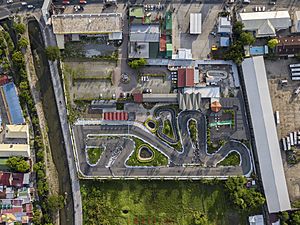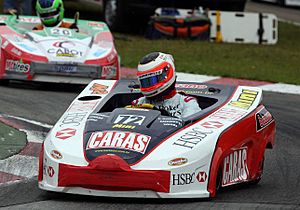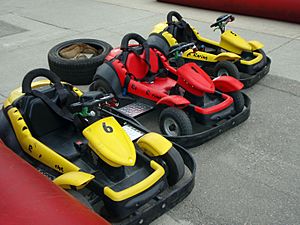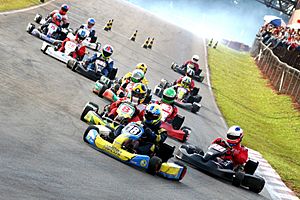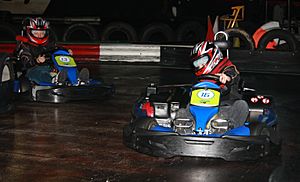Kart racing facts for kids
Kart racing (also called karting) is a fun type of motor sport. It uses small, open, four-wheeled vehicles known as karts or go-karts. These karts are usually raced on special, smaller tracks called kart circuits. Many people see karting as a first step into the exciting world of car racing.
Karts can go at very different speeds. Some special racing karts, called Superkarts, can zoom past 160 miles per hour (260 km/h)! But the go-karts you might rent for fun are much slower, often limited to about 15 miles per hour (24 km/h).
Contents
History of Karting
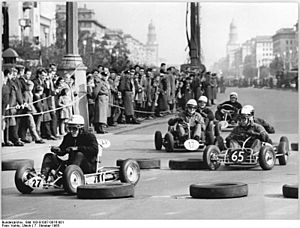
The idea for karting started in Southern California in 1956. A man named Art Ingels is known as the "father of karting." He loved building fast cars and worked at a company called Kurtis Kraft. Art built the very first kart, and soon, many others wanted to try this new sport!
How Karts Are Built
Kart Chassis
The main frame of a kart, called the chassis, is made from steel tubes. Unlike a regular car, karts do not have a separate suspension system. Instead, the chassis itself is designed to bend and flex. This bending acts like the suspension, helping the kart handle bumps and turns.
Karts have different chassis designs:
- Open karts do not have a safety cage around the driver.
- Caged karts have a strong roll cage to protect the driver.
To slow down, karts use a disc brake on the rear axle. Some karts also have front disc brakes, but not all racing classes allow them.
Kart Engines
Karts used at amusement parks often have 4-stroke engines or electric motors. Racing karts use smaller, powerful 2-stroke or 4-stroke engines. These engines are built for speed and quick acceleration.
How Karts Move
Karts are unique because both rear wheels turn at the same speed. This means that when a kart goes around a corner, one of the rear tires has to slide a little bit. Power from the engine goes to the rear axle using a chain, similar to a bicycle.
Kart Tires
The wheels and tires on a kart are much smaller than those on a normal car. Just like in other types of racing, karts use different tires for different weather conditions.
- Slicks are smooth tires used when the track is dry.
- Rain tires (or "wets") have grooves to help grip in wet weather.
- Tires with grooves cut into them are used for dirt tracks.
- Special spiked tires are used for racing on ice!
Kart Racing
Kart racing is often seen as the most affordable way to get into motorsport. It's a fun hobby that almost anyone can enjoy. For serious racers, karting is regulated by big organizations like the FIA (through its CIK branch).
In the USA, groups like the International Kart Federation (IKF) and World Karting Association (WKA) organize races. In the UK, the Motor Sports Association (MSA) handles karting rules. Australia has the Australian Karting Association. These groups make sure races are fair and safe.
Karting as a Learning Tool
Kart racing is a great way to learn about motor racing. It's not just for young drivers; adults also love karting! Many famous race car drivers, like Lewis Hamilton and Michael Schumacher, started their careers in karts. Karting helps drivers learn important skills like:
- Having quick reflexes.
- Controlling the car precisely.
- Making fast decisions during a race.
Fun Karts for Everyone
Besides serious racing, many places offer karts for rent. These are often called "recreational" or "concession" karts. You can find them at indoor or outdoor tracks. You usually rent them for short sessions, like 10 or 15 minutes. These karts have strong frames and bodywork to keep drivers safe.
Outdoor tracks might have slower karts just for fun, or faster karts that are more like racing karts. Sometimes, these outdoor tracks are also used for official kart races.
Images for kids
-
Kart racing in Illinois in 1962.
-
A pack of laydown enduros at Daytona International Speedway.
See also
 In Spanish: Karting para niños
In Spanish: Karting para niños



